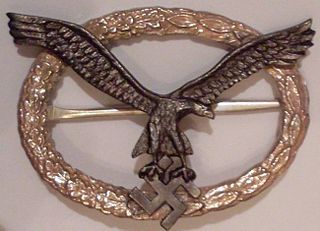 W
WThe 88th Infantry Regiment was an infantry regiment of the United States Army. It was created as the 88th Airborne Infantry Battalion on 10 October 1941 during World War II as the U.S. Army's first glider infantry unit.
 W
WThe 188th Glider Infantry Regiment was a regiment in the United States Army that was active during World War II. It was a part of the 11th Airborne Division during its entire existence.
 W
WThe 193rd Glider Infantry Regiment was an airborne infantry regiment of the United States Army during World War II. It was part of the 17th Airborne Division and fought during the Battle of the Bulge.
 W
WThe 194th Glider Infantry Regiment was a Glider infantry regiment of the United States Army that served in World War II. It was a part of the 17th Airborne Division, and saw active combat service until its deactivation in 1945.
 W
WThe Aircrew Badge was a German military decoration awarded to members of the German Air Sports Association, an organisation set up by the Nazi Party in March 1933 to establish a uniform basis for the training of military pilots. The German Air Sports Association was a cover organization for the future German Air Force (Luftwaffe). Its chairman was the future Commander in Chief of the Luftwaffe Hermann Göring and its vice-chairman Ernst Röhm. Since the Treaty of Versailles officially forbade Germany from building fighter planes of any sort, the German Air Sports Association used gliders to train men who were still officially civilians for the future Luftwaffe. It was the first qualification badge recognized by the Luftwaffe.
 W
WMilitary gliders have been used by the militaries of various countries for carrying troops and heavy equipment to a combat zone, mainly during the Second World War. These engineless aircraft were towed into the air and most of the way to their target by military transport planes, e.g., C-47 Skytrain or Dakota, or bombers relegated to secondary activities, e.g., Short Stirling. Most military gliders do not soar, although there were attempts to build military sailplanes as well, such as the DFS 228.
 W
WThe Glider Badge was a special skills badge of the United States Army. According to the U.S. Army Institute of Heraldry, the badge was awarded to personnel who had "been assigned or attached to a glider or airborne unit or to the Airborne Department of the Infantry School; satisfactorily completed a course of instruction, or participated in at least one combat glider mission into enemy-held territory.
 W
WThe Glider Pilot's Badge was a German military decoration that was awarded during World War II to military pilot's who were members of the German Air Force (Luftwaffe) after they completed their glider training. Honorably discharged personnel who met the requirements could also be awarded the badge. A citation was issued with the awarded badge. It was worn on or right below the left breast tunic pocket.
 W
WThe Glider Pilot Regiment was a British airborne forces unit of the Second World War, which was responsible for crewing the British Army's military gliders and saw action in the European theatre in support of Allied airborne operations. Established in 1942, the regiment was disbanded in 1957.
 W
WGlider infantry was a type of airborne infantry in which soldiers and their equipment were inserted into enemy-controlled territory via military glider. Initially developed in the late 1930s by Germany, glider infantry units were used extensively during World War II but are no longer used by any modern military.
 W
WThe National Socialist Flyers Corps was a paramilitary organization of the Nazi Party.
 W
WThe Royal Air Force Gliding & Soaring Association is a British organisation which provides recreational flying in gliders to RAF personnel.
 W
WThe glider snatch pick-up technique was used by the Allies of World War II. It allowed military gliders to be launched from a stationary position on the ground by a low-flying powered aircraft, flying low overhead, which did not have to land.